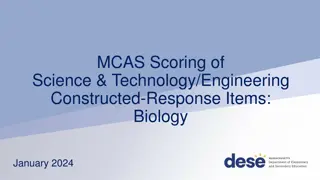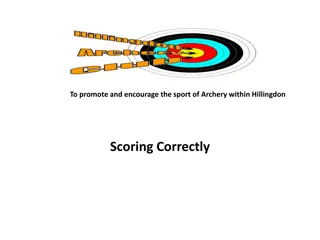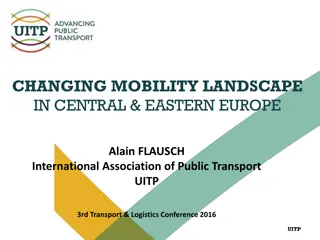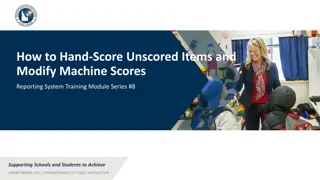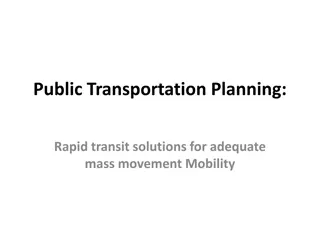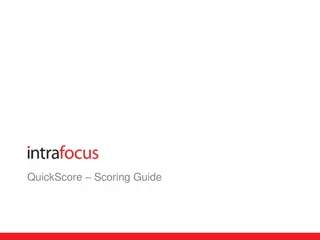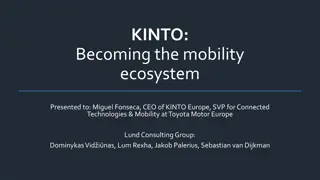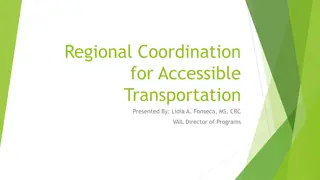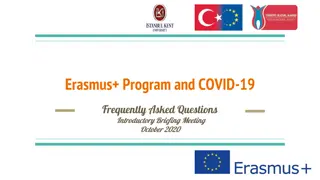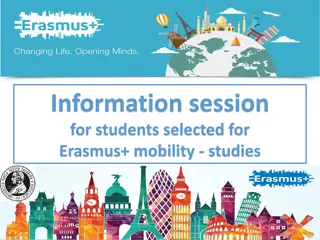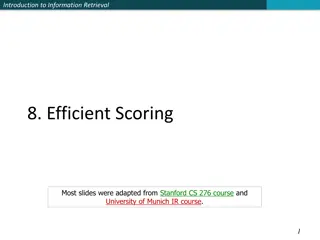Public Transportation Scoring and Project Categories: Enhancing Mobility in NC
Explore a detailed overview of public transportation scoring for prioritization in North Carolina, focusing on project categories, impact funding, and demand/density criteria. Learn about models in different transit elements and how projects are assessed based on mobility, efficiency, cost, and effectiveness factors. Dive into the intricacies of regional impact, division needs, and the types of projects considered for funding in the state.
Download Presentation

Please find below an Image/Link to download the presentation.
The content on the website is provided AS IS for your information and personal use only. It may not be sold, licensed, or shared on other websites without obtaining consent from the author.If you encounter any issues during the download, it is possible that the publisher has removed the file from their server.
You are allowed to download the files provided on this website for personal or commercial use, subject to the condition that they are used lawfully. All files are the property of their respective owners.
The content on the website is provided AS IS for your information and personal use only. It may not be sold, licensed, or shared on other websites without obtaining consent from the author.
E N D
Presentation Transcript
Model Data in Public Transportation Scoring for Prioritization NCDOT Strategic Prioritization Office Sarah Lee and Jason Schronce November 5, 2019
Models in NC Transit Elements: Triangle (CAMPO and DCHC) Triad (Greensboro, Winston Salem, High Point, & Burlington) Metrolina (Cabarrus-Rowan, GCL, and CRTPO) French Board River Fayetteville Greenville Wilmington 2
Project Categories for P6.0 Projects are scored in 3 separate categories: Mobility (Route-Specific) Demand-Response Facility Projects are submitted under Specific Improvement Types: 1 - Mobility (route-specific) - New Service * 2 - Mobility (route-specific) - Headway Reduction * 3 - Mobility (route-specific) - Extension * 4 - Demand Response 5 - Facility - Passenger Station * 6 - Facility - Stop/Shelter * 7 - Facility - Park and Ride * 8 - Facility - Administrative 9 - Facility - Maintenance * = typically use modeled data
Public Transportation Scoring: Mobility Regional Impact (70%) Division Needs (50%) Criteria Measure Impact Number of trips affected by project 15% 10% Demand/ Density Total Trips / Service population 20% 10% Efficiency Total trips / Total revenue seat hours 10% 10% Cost Additional trips / 25% 20% Effectiveness (Cost to NCDOT / Lifespan of project) Project Types: Route-specific vehicles (new or expansion only) Fixed guideway vehicles, fixed route vehicles, deviated fixed route vehicles Corridors Fixed guideway (commuter rail, intercity rail, light rail) Bundle of vehicle + other (ex. stops / shelters, park and rides, bus pullouts) Bus Rapid Transit (BRT) Bus on Shoulder System (BOSS) / Busway 9
Impact Funding Category Statewide Mobility Regional Impact Division Needs Criteria Weight N/A 15% 10% Purpose: Measure the number of trips affected by the project Measure: New routes: Additional annual trips [project] Headway Reduction: Additional annual trips [project] + Relieved existing annual trips [route] Notes: Additional Trips = 10 years in the future with new/expanded service (2029) 10
Demand / Density Funding Category Statewide Mobility Regional Impact Division Needs Criteria Weight N/A 20% 10% Purpose: Measure the total trips on the route compared to the population serviced by the route Measure: (Existing annual trips [route] + Additional annual trips [project]) / Service population [route] Notes: Additional Trips = 10 years in the future with new/expanded service (2029) Service Population (reported to NTD): Local Route = mile per stop Express Route = mile per stop (5 mile per park & ride) (Express Route = No complementary ADA paratransit) 11
Efficiency Funding Category Statewide Mobility Regional Impact Division Needs Criteria Weight N/A 10% 10% Purpose: Measure the total trips on the route with the project in place compared to the total revenue seat hours on the route with the project in place Measure: (Existing annual trips [route] + Additional annual trips [project]) (Existing annual rev. hours [route] + Additional annual rev. hours [project]) x (Existing seats [route SUM] + Additional seats [project SUM]) Notes: Additional Trips = 10 years in the future with new/expanded service (2029) 12
Cost Effectiveness Funding Category Statewide Mobility Regional Impact Division Needs Criteria Weight N/A 25% 20% Purpose: Measure the additional trips generated by the project compared to the annualized cost to NCDOT Measure: Additional annual trips [project] / (Cost to NCDOT / Lifespan of project) Notes: Additional Trips = 10 years in the future with new/expanded service (2029) 13
Public Transportation Scoring: Demand Response Regional Impact (70%) Division Needs (50%) Criteria Measure Impact Number of trips affected by project 10% 10% Demand/ Density Total hours with the project in place / Service population 20% 15% Efficiency Vehicle Utilization Ratio 15% 10% Cost Additional trips / 25% 15% Effectiveness (Cost to NCDOT / Lifespan of project) Project Types: Demand Response vehicles (expansion only) No facilities either submit Demand Response facilities under Facility category or under Mobility category if bundled with a vehicle 14
Public Transportation Scoring: Facilities Division Needs (50%) Criteria Measure Impact Number of trips affected by project 15% Demand/ Density Ridership Growth Trend for the Previous 5 Years 10% Efficiency Efficiency Score 10% Cost Additional trips / 15% Effectiveness (Cost to NCDOT / Lifespan of project) Project Types: Passenger stations Individual or bundled stops/shelters Individual or bundled park and ride lots Administrative / Maintenance buildings 19
Model Data in P5.0 Models used for trip data on projects within areas with regional models with transit elements Prioritization scoring uses annual trips, but models use daily trips Coordination meetings on model data brought to light that transit systems have different numbers of operating days Different methods of annualizing daily trip numbers for Prioritization scoring Consistency seemed best, so project submitters were asked to provide either daily trips or annualization factors they used Consistent annualization factor of 260 was then used with daily trips to derive new values for annual trips for Prioritization scoring Process was applied to all project types (Mobility, Demand Response, and Facilities) for modeled and non-modeled data 26
Model Data in P5.0 Benefit = projects were only submitted from one regional model To ensure consistency, multiple meetings were held between CAMPO, DCHC, and TJCOG Goal = consistent inputs that ensured results were calculated consistently Also incorporated a third party review of input files to verify consistency Issues with this process: Data collection timing of coordination meant additional data was requested via email Communication of desired data and definition of daily vs. annual Different methods of obtaining and projecting data for scoring modeled vs. non-modeled 27
Model Data in P6.0 Intent of Transit scoring data is to be as accurate as possible, and not penalize or reward unnecessarily Decided to no longer use a common annualization factor Scoring will utilize the annual numbers as submitted by each system/project (based on each system s actual number of operating days) 28
Model Data in P6.0 Concern = will likely have projects submitted from multiple regional models In need of feedback from subject matter experts is consistency possible for inputs/results across different models? Discussion points: What should be consistent between models vs. not? (what to focus on or not) Off-model data vs. on-model? How much better is the Transit growth data from the model vs. basic projections? (what does it track?) (i.e. is using the model better?) Is SE growth data from the model a better proxy than previous 5 years? 29
Next Steps Meet with organizations that are potentially submitting P6.0 projects that will use Transit model data Ideas for P7.0 Transit scoring? 30
Contact Information Jason Schronce, P.E. SPOT Manager Prioritization Office (SPOT) (919) 707-4646 jschronce@ncdot.gov Sarah E. Lee Prioritization Office (SPOT) Non-Highway Modes (919) 707-4742 selee@ncdot.gov Austin Chamberlain Prioritization Office (SPOT) TOP3s / GIS Support (919) 707-4650 sachamberlain@ncdot.gov Justin Green, P.E. Prioritization Office (SPOT) Highway Mode (919) 707-4613 jdgreen@ncdot.gov https://www.ncdot.gov/sti spot@ncdot.gov (Jason, Sarah, Austin, Justin) 31




